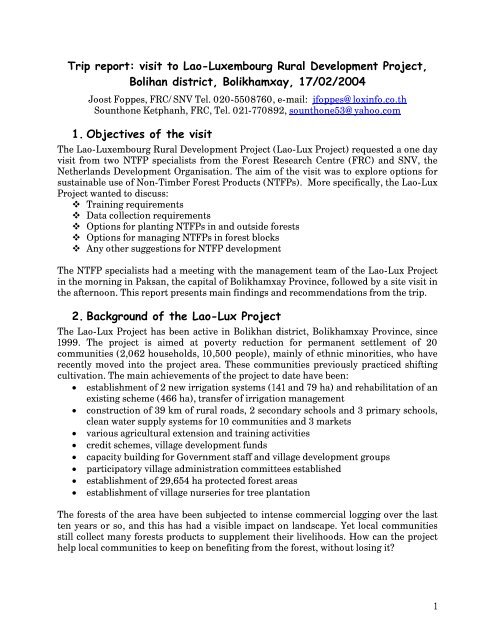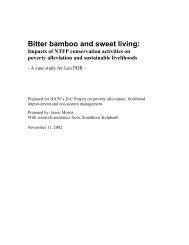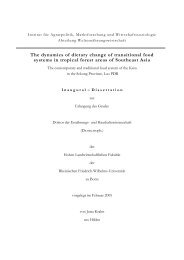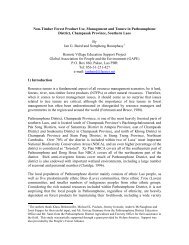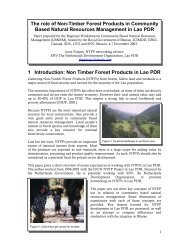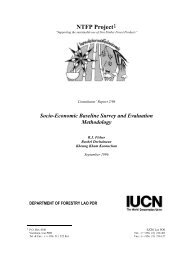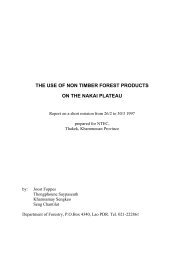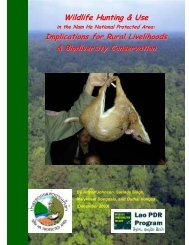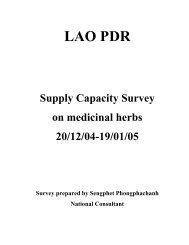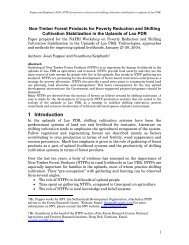You also want an ePaper? Increase the reach of your titles
YUMPU automatically turns print PDFs into web optimized ePapers that Google loves.
<strong>Trip</strong> <strong>report</strong>: visit to Lao-Luxembourg Rural Development Project,<br />
Bolihan district, <strong>Bolikha</strong>mxay, 17/02/2004<br />
Joost Foppes, FRC/SNV Tel. 020-5508760, e-mail: jfoppes@loxinfo.co.th<br />
Sounthone Ketphanh, FRC, Tel. 021-770892, sounthone53@yahoo.com<br />
1. Objectives of the visit<br />
The Lao-Luxembourg Rural Development Project (Lao-Lux Project) requested a one day<br />
visit from two NTFP specialists from the Forest Research Centre (FRC) and SNV, the<br />
Netherlands Development Organisation. The aim of the visit was to explore options for<br />
sustainable use of Non-Timber Forest Products (NTFPs). More specifically, the Lao-Lux<br />
Project wanted to discuss:<br />
Training requirements<br />
Data collection requirements<br />
Options for planting NTFPs in and outside forests<br />
Options for managing NTFPs in forest blocks<br />
Any other suggestions for NTFP development<br />
The NTFP specialists had a meeting with the management team of the Lao-Lux Project<br />
in the morning in Paksan, the capital of <strong>Bolikha</strong>mxay Province, followed by a site visit in<br />
the afternoon. This <strong>report</strong> presents main findings and recommendations from the trip.<br />
2. Background of the Lao-Lux Project<br />
The Lao-Lux Project has been active in <strong>Bolikha</strong>n district, <strong>Bolikha</strong>mxay Province, since<br />
1999. The project is aimed at poverty reduction for permanent settlement of 20<br />
communities (2,062 households, 10,500 people), mainly of ethnic minorities, who have<br />
recently moved into the project area. These communities previously practiced shifting<br />
cultivation. The main achievements of the project to date have been:<br />
• establishment of 2 new irrigation systems (141 and 79 ha) and rehabilitation of an<br />
existing scheme (466 ha), transfer of irrigation management<br />
• construction of 39 km of rural roads, 2 secondary schools and 3 primary schools,<br />
clean water supply systems for 10 communities and 3 markets<br />
• various agricultural extension and training activities<br />
• credit schemes, village development funds<br />
• capacity building for Government staff and village development groups<br />
• participatory village administration committees established<br />
• establishment of 29,654 ha protected forest areas<br />
• establishment of village nurseries for tree plantation<br />
The forests of the area have been subjected to intense commercial logging over the last<br />
ten years or so, and this has had a visible impact on landscape. Yet local communities<br />
still collect many forests products to supplement their livelihoods. How can the project<br />
help local communities to keep on benefiting from the forest, without losing it?<br />
1
3. Meeting with management team<br />
The participants in the meeting were:<br />
Mr. Keo Oudone, head of forestry, Province <strong>Bolikha</strong>mxay<br />
Mr. Sonexay, head of forestry, <strong>Bolikha</strong>n district<br />
Ms. Southa, acting national project coordinator, Lao-Lux Project<br />
Ms. Sheena Sloan, teamleader, Lao-Lux Project<br />
Mr. Manisengphet, province liaison officer, Lao-Lux project<br />
Mr. Sounthone Ketphanh, deputy director, Forest Research Centre (FRC)<br />
Mr. Joost Foppes, NTFP adviser, SNV-FRC<br />
The meeting covered the following topics:<br />
1) Reviewing the project activities in forestry to date<br />
2) Brainstorming on key NTFP products, production and marketing issues<br />
3) Training requirements<br />
A) Project Activites in forestry to date<br />
The project has assisted in the establishment of four protected forest areas:<br />
- Phou Meuang, 4,150 ha (around Ban Nalong)<br />
- Phou Phalan, 4,032 ha (around the Muang Huang)<br />
- Phou Meun/Nam Xao, 5,200 ha (around Muang Bo)<br />
- Phou Heo/Phou Hat/Phou Mathan, 20,800 ha (Ban Thasy/Xieng Leu area)<br />
In total these areas cover 34,182 ha. The areas have been mapped and general access<br />
regulations seem to have been drawn up. There not yet any specific guidelines on NTFP<br />
extraction from these forests. The project also supports a tree nursery at Houay Kham,<br />
which produced 65,000 tree seedlings, mainly fruit trees and agarwood (Aquilaria sp.),<br />
distributed for planting in 2003. It is too early to say how these plantations perform.<br />
B) Key NTFPs from the project area<br />
Participants identified 14 key NTFPs collected from the project area (see table 1 below).<br />
Table 1: Lao-Lux Project team’s short list of NTFPs, with price estimates (February 2004).<br />
No Lao name Latin name Description Price /kg<br />
1 Khisi Vatica sp. Hard damar resin 500 kip<br />
2 Nyod boun Daemonorops schmidtiana Large edible rattan shoots 1,000 kip<br />
4 Vai thoun Calamus poilanei Large diameter rattan for furniture 5,000 kip<br />
5 Vai noi Calamus solitarius and others Small diameter rattan for furniture 1,000 kip<br />
6 Mak tao Arenga westerhoutii Palm fruits used as sweets 1,500 kip<br />
7 Mak neng Amomum sp. Chinese cardamom, medicine 1,000 kip<br />
8 Khem Thysanolaema maxima Grass used to make brooms ?<br />
3 Nyod san Raphis sp. Small edible palm shoots 3,000 kip<br />
9 Nor Mai Many Dendrocalamus sp. Edible bamboo-shoots 500 kip<br />
10 Hed Many species Mushrooms ?<br />
11 Pak wan Melientha suavis Forest vegetable 3,000 kip<br />
12 Mai ketsana Aquilaria crassna Agarwood, a valuable scented wood variable<br />
13 Mai hia Schizostachyum virgatum Bamboo canes 1,000 kip<br />
14 Yang bong Persea kurzii Bark used for incense making 3,000 kip<br />
2
Participants tried to prioritise some of these products for action, using several criteria,<br />
e.g. income raising potential, sustainability, social impact (no of families involved),<br />
suitability for planting, in-forest management or marketing improvement (see table 2).<br />
This type of priority ranking could be applied also at village level.<br />
Table 2: example of prioritising NTFPs for action according to several criteria<br />
Product Income Sustainable Many families Planting In-forest Marketing<br />
Khisi high low very many no need yes ?<br />
Boun/san medium medium everybody no need yes very good<br />
Vai thoun high depleted many hard: 20 years yes good<br />
Mak tao medium low many no need yes good<br />
Mak neng low high many 4 years yes ?<br />
Khem medium high many no need no need good<br />
Nor Mai low low everybody 4 years maybe good<br />
Hed low good some how? how? good<br />
Pak wan low good some 2 years no ?<br />
Ketsana high depleted only a few hard: 15 years seed trees ?<br />
C) Discussion on sustainable NTFP options management options<br />
Some key products are becoming very hard to find due to commercial exploitation, e.g.<br />
the large rattan “vai thoun”, bong bark and “ketsana”, agarwood. It would seem urgent to<br />
promote plantations of these products, but who will do it? Cultivation of agarwood trees<br />
is possible, but the techniques for producing the valuable bits of black wood are still not<br />
available. Until this problem has been solved, it is not recommendable to invest in<br />
agarwood plantations.<br />
There is little incentive for poor families to plant rattan for canes and wait 15-20 years<br />
before the canes are grown. This is too a risky enterprise for small farmers, it is better<br />
left to private companies. However, private companies in the area seem also reluctant to<br />
invest in long-term commercial rattan plantations. The Lao-Lux Project best bet would<br />
probably be to assist the Province Forestry Department in starting trial plantations of<br />
rattan for cane production around the nursery at Houay Kham. It would especially be<br />
wise to pay villagers to collect rattan seed from the forest and protect seed sources,<br />
before it is too late. The intended effect would be to raise awareness among private<br />
sector investors on the potential for growing rattan and securing a stock of seed material<br />
for the future.<br />
Bong bark can easily be planted and is ready for harvesting after 5-7 years, production<br />
and marketing seem much more secure. This may be a better alternative for income<br />
raising among poor families. Hundreds of families are already engaged in bong planting<br />
in Salavan and Champasak provinces, with support of the local Province Forestry Offices<br />
there. The Lao-Lux Project could consider a study visit to these provinces.<br />
For some other products, e.g. bamboo, cardamom and mak tao palm fruits, it may be<br />
easier to promote sustainable harvesting from the forest. Several issues remain to be<br />
addressed by the project to achieve sustainable harvesting systems:<br />
- How could local communities become motivated to invest time and labour into<br />
managing forest resources in the area? What incentives could be offered to them?<br />
3
- Who is the owner of the forest? What are the access/use rights of villagers<br />
compared to the logging company and the Government?<br />
- What is the process by which access/off-take regulations will be drawn? How will<br />
villagers participate in that process?<br />
- How could villages set limits for the amounts of products allowed to be taken out<br />
of the forest (village quota’s?) without depleting the resource?<br />
- How can clusters of villages, all using the same block of forest, agree to respect<br />
the same rules on access and NTFP harvesting?<br />
- How can villagers get a fair price for their products, how will prices be determined<br />
- Who will connect the villagers with markets inside and outside Lao PDR?<br />
D) Marketing options<br />
The income from NTFPs seems to be declining in the project area and buyers seem to be<br />
moving away. It is difficult to see immediate areas for improvement. Ideally, the Project<br />
should implement an NTFP Marketing Analysis and Micro Enterprise Development<br />
Approach, as developed by FAO/RECOFTC. However, there may not be enough time<br />
and money left for such an approach. During further brainstorming on marketing<br />
options, a number of ideas were proposed for action:<br />
- Linking NTFP selling groups to the on-going credit program of the project<br />
- Province level stakeholder meeting on marketing of rattan canes and shoots<br />
- Using the project’s links with Europe to link local rattan producers to European<br />
furniture markets<br />
- Try to identify local market opportunities, e.g. for edible shoots of rattans<br />
(“boun/san”) to the cities of Thakek, Savannakhet and Vientiane.<br />
- Identify 2-3 promising products and hire local/regional consultants to do an indepth<br />
marketing/feasibility study for processing/marketing of these products<br />
E) Capacity Building<br />
NTFP activities can only be successful if they are developed with and carried out by the<br />
local communities. A participatory approach is required to achieve such local ownership.<br />
Based on earlier experiences with NTFP development in Lao PDR, the consultants<br />
recommended that such an approach should comprise the following steps:<br />
- Basic analysis/awareness raising/ initial staff training (1 week)<br />
- RRA baseline data collection (2 weeks)<br />
- Translating RRA findings to options for action (1 week)<br />
- Target group formation (2 weeks)<br />
- Exposure of target groups to new ideas/options (e.g. by study tours) (2 weeks)<br />
- Planning activities with target groups (2 weeks)<br />
- Agreements between target groups and project for implementation (3 weeks)<br />
- Implementation (6-12 months)<br />
- Monitoring and Evaluation ( 1 month)<br />
The project needs to reflect if it still has the time and means to go through such a<br />
process. The approach would require a training plan. We discussed some key questions<br />
to be considered by the project. Who will be the trainers/facilitators? Suitable people<br />
could be selected from various district organisations, e.g. Lao Women’s Union,<br />
4
Agriculture and Forestry Office, Trade Office. How many villages, how many families,<br />
how many trainers are to be involved? Because NTFPs are often little understood, it<br />
might be useful to start with a short training of staff to undertake rapid NTFP appraisal<br />
studies in villages surrounding the four protected forests. Methods for this have been<br />
published in Lao language, the Forest Research Centre can assist in finding suitable<br />
trainers of trainers. Study tours could be considered to Bachiang district, Champasak,<br />
where various NTFPs are being planted by local villagers (Contact: Ms. Vansi<br />
Chantapone, PAFO Champasak, tel. 020-5531141). Another option is to visit the area of<br />
Sakhon Nakhon in neighbouring Thailand, where many families grow rattan<br />
commercially for edible shoot production (Contact: Mr. Charnchai Ngamcharoen, Royal<br />
Forestry Department, Bangkok, tel: +66-2-561-439-23).<br />
4. Field visit findings<br />
During the afternoon, Mr. Sonexai and Mr. Manivengpeth took the consultants on a tour<br />
by car to the project tree nursery at Houay Kham and the nearby village of Ban Dong. On<br />
the way back, a short visit was also made to a rattan processing factory outside Paksan.<br />
The nursery contains around 20 beds of seedlings. Most of the beds were filled with<br />
timber tree species (teak, Tectona grandis, 6 beds; rosewood, Afzelia xylocarpa, 2;<br />
Acacia mangium, 2). There were also 2 beds of agarwood seedlings, 3 with “vai nyeh”<br />
rattan seedlings (for edible shoot production) and 4 beds with various fruit tree species.<br />
Most of the seedlings of timber tree species and agarwood are <strong>report</strong>edly bought by local<br />
timber companies, the fruit tree seedlings and rattan are mostly in demand by the<br />
villagers. The nursery has running water from an irrigation canal, it is potentially a good<br />
site to mass-produce seedlings of any kind.<br />
In the village of Ban Dong we had a chance to meet the village headman and around<br />
eight other long-term residents (5 men, 3 women). They belong to the minority of 35<br />
original families who have always lived here. The total number of families in the village<br />
is now 108 families, most of the newcomers arrived around 1990.<br />
It is important to note this, as the people we met seemed to be the only ones who were<br />
not out of the village, collecting non-timber forest products at the time of our visit<br />
(around 15.oo-16.00 PM in the peak of the dry season). They gave the impression that<br />
NTFPs were not very important for their family economy. This could well be true for<br />
them, as they are the older well-established families who get most of their income from<br />
growing rice. It remains to be seen if this is also true for the larger group of poorer<br />
recently immigrated families, who we could not meet as they were absent.<br />
The village has an impressive area of 180 ha of rainy season wet paddy land at its<br />
disposal, of which 15 ha are irrigated and useable for a second rice crop in the dry<br />
season. The people we met estimated that selling of rice is the most important income<br />
source of the village. They estimated that an average family could earn around 1.5<br />
million kip per year from selling rice (50%), 1 million from livestock (33%) and 0.5-1<br />
million from selling NTFPs (16-33%). They broke down the total sales of NTFPs in the<br />
village as presented in the table 3 below.<br />
5
Table 3: Estimated income from selling NTFPs in Ban Dong, 2003.<br />
Product Quantity (2003) Total Value Income per family<br />
Vai thoun rattans 5,000 canes @ 7,000 kip 35 million kip 324,000 kip<br />
Khisi resin 2o tonnes @ 1,000 kip 20 million kip 185,000 kip<br />
Yang oil 1,000 liter @ 1,500 kip 1.5 million kip 14,000 kip<br />
Peuak meuak bark 2 tonnes @ 3,000 kip 6 million kip 55,000 kip<br />
TOTAL 62.5 million kip 578,000 kip<br />
It is interesting to note that two of the four products on this very short list were not<br />
previously identified by the Project team: yang oil, an exudate of a large timber tree<br />
(Dipterocarpus alatus), and peuak meuak, the bark of a tree used for chewing with betel<br />
nut (Artocarpus species, N.B. not to be confused with “peuak meak” from northern Laos,<br />
a bark from Boehmeria malabarica, used for incense making). This illustrates the need<br />
for project teams to collect actual data at village level.<br />
The share of income provided by NTFPs seems to be rather low compared to other<br />
remote areas in Lao PDR (average 50% according to earlier surveys by the consultants).<br />
One reason for this may be that the area seems to have an unusual high availability of<br />
wet paddy land, making rice the number one economic activity as claimed by the<br />
interviewed villagers. We did not have time to collect and compare actual rice production<br />
figures and compare them to population figures for the area. If the project has such data,<br />
it would be interesting to compare rice production and consumption to confirm the<br />
claims of large surplus rice production.<br />
A possible second reason could be that NTFPs supplies have simply been exhausted, as<br />
most of the forest in the area is heavily degraded due to logging and intensive shifting<br />
cultivation, as a result of the rapid influx of people into the area over the last fifteen<br />
years or so. More detailed surveys would be needed to assert this hypothesis, linking<br />
NTFP off-takes to actual forest blocks where they are derived from.<br />
A third reason may be that prices of some NTFPs seem to have fallen over the last few<br />
years. An example was given by the villagers of Ban Dong. Up to two years ago, the<br />
village used to sell around 500 kg per year of dry Chinese cardamom (“mak neng”,<br />
Amomum sp.). The price was around 30,000 kip/kg, giving an income from this product<br />
alone of 15 million kip for the whole village or 139,000 kip per family. The price has now<br />
dropped to around 12,000 kip/kg, as a result traders are no longer coming to the village<br />
to buy this product. A survey of past trends in prices/off-takes of NTFPs could shed<br />
more light on the development of the NTFP market in the area over recent years.<br />
The total land area of the village amounts up to 5,000 ha. This includes two important<br />
blocks of mature forest (“dong”): Dong Phou Pasang (400ha) and Houay Sanyeng<br />
(200ha), both around 1 hour walking distance from the village. There is still a lot of<br />
wildlife, especially deer (sambar deer, “kwang”, and muncak deer,“fan”) also duiker<br />
antelopes (“kai”) and various species of snakes. Several other villages use the same forest<br />
blocks as well.<br />
6
The unanswered question remains what is the status of the remaining 4,000 or so ha of<br />
village land. From our incomplete visual observation it would seem that most of the<br />
remaining forest land is heavily degraded fallow-land, which was first logged over by<br />
various logging companies and then used for upland rice cultivation. Erosion is visible at<br />
several places and natural regeneration of the vegetation seems to be slow. It would<br />
seem that the rehabilitation of these large tracts of land requires more attention.<br />
We could neither get a clear answer on the ownership status of these lands, nor on the<br />
rights of villagers to use these lands, nor on the land use planning for them. Some people<br />
mentioned that these lands are still belonging to logging companies who are expected to<br />
plant production forests, others thought they were protected forests, again others<br />
suggested these lands could be available for villagers to develop tree gardens. It would<br />
seem urgent to clarify this issue.<br />
The interviewed villagers mentioned that vai thoun and “kheua wa” (another type of<br />
rattan, similar to vai thoun but with red seeds), are the most rapidly depleting NTFP in<br />
the forest. The villagers we met were not very interested in planting rattan for cane, as<br />
they are not sure who would be the owner of the plantation. They also feel it would take a<br />
long time to mature and they are not sure about the market in that distant future.<br />
On the way back to Paksan, we met Mr. Khamla Sayboumi and Mr. Van Meuy of the<br />
“Hongngan Poungteng Vai Leh Mai Phai” (Rattan and Bamboo Processing Factory).<br />
This factory processes rattan canes by boiling canes in a preservative solution, followed<br />
by stretching, drying and polishing. The resulting product is destined for export to<br />
Vietnam for furniture making. Last year, the company bought around 40,000 stems of<br />
big diameter cane (“vai thoun”) and around 30,000 stems of small diameter cane (“vai<br />
hang nou” and “vai tok”). Each year, the company buys less big canes and more small<br />
canes, as the big canes are getting harder and harder to find. The company does not<br />
expect to be able to continue its business for more than five years. There are apparently<br />
two other similar sized rattan exporting companies in/around Paksan.<br />
The growing time for plantations of big canes (“vai thoun”) is estimated to be 20-25<br />
years. The growing time for plantations of small cane (“vai hang nou”) is expected to be<br />
around 10 years, which may be more economically feasible. In either case, it would seem<br />
urgent to start planting now, before natural stocks are completely exhausted. The<br />
company has so far not considered investing in commercial rattan cane plantations.<br />
7
5. Recommendations<br />
By way of conclusion, the following actions are recommended to the project:<br />
A) Training:<br />
‣ Train district staff to:<br />
- learn to analyse status of NTFP use and dependency in project villages<br />
- learn with villagers about NTFP options through study tours<br />
- plan and implement suitable activities through agreement with villagers<br />
B) Data collection:<br />
‣ Document actual NTFP use and dependency in project villages, in comparison to<br />
other livelihood and income sources (e.g. rice, livestock)<br />
‣ Map forest areas where NTFPs are collected and estimate yields from each block<br />
for key products, as a basis for management rules<br />
‣ Identify sustainable harvesting systems for key NTFPs based on local knowledge<br />
‣ Study NTFP marketing history, options and constraints<br />
C) Options for planting NTFPs<br />
‣ Explore the feasibility of bong bark plantations with local communities<br />
‣ Promote rattan cane plantations, collect/conserve seed/planting stock<br />
D) Options for NTFP management in forest<br />
‣ Clarify the ownership and access rights to all lands in the project area, promoting<br />
village access and security to encourage sustainable use<br />
‣ Develop specific targets and arrangements for sustainable use of NTFPs as well a<br />
regeneration/reforestation of degraded forest land<br />
E) Other options:<br />
‣ Link NTFP selling groups to the on-going credit program of the project<br />
‣ Organize a stakeholder meeting on marketing of rattan canes and shoots<br />
‣ Link local rattan producers to European furniture markets<br />
‣ Identify local market opportunities, e.g. for edible shoots of rattans (“boun/san”)<br />
to the cities of Thakek, Savannakhet and Vientiane.<br />
‣ Identify 2-3 promising products and hire local/regional consultants to do an indepth<br />
marketing/feasibility study for processing/marketing of these products<br />
8


